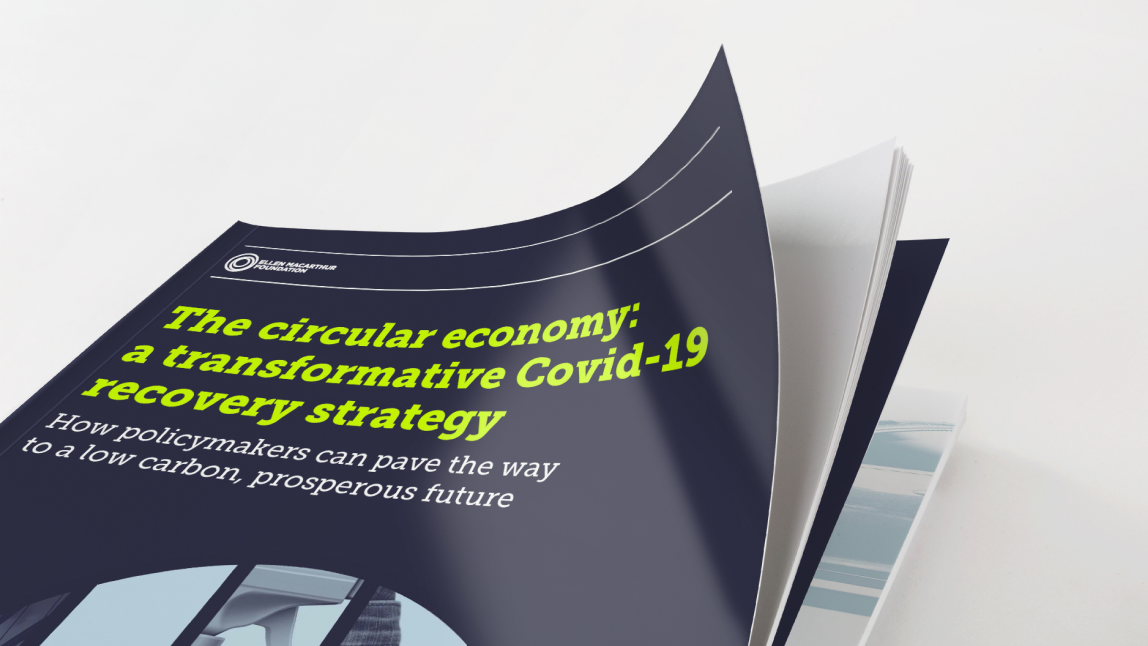Setting a common direction of travel: a resilient recovery with the circular economy
There are still many uncertainties about how the economic landscape will evolve. The many uncertainties that remain around the Covid-19 virus and its potential cure—through a vaccine or a widely available treatment—are still weighing on the economy and people's lives and livelihoods.
There are also uncertainties around the economic impact of the pandemic, the policy responses, the speed of recovery, and the extent to which pandemic-induced shifts will persist in society e.g. shifting consumer patterns, business travel, working from home. As a result, macroeconomic projections are showing massive divergences, and while policymakers are providing unprecedented support to households, firms, and financial markets, a McKinsey study highlights that the uncertainty is still present which is “toxic for an economic recovery”. It is therefore important to establish clear visions and to align strategies towards a new economic model for long-term prosperity and resilience.
Ambitious policies will be needed that not only focus on short-term ‘rescue’, but also on long-term ‘recovery’ efforts. At a global level, it is such that although an estimated that 30% of all economic stimulus funding is being directed to areas with highly relevant impacts on the environment, yet most of this is being mobilised without any clear environmental conditions. In fact, studies have shown that the vast majority of the policies for economic stimulus—that have already been implemented in G20 countries since the onset of the pandemic—are more ‘rescue’ than ‘recovery’ policies, paying limited attention to climate, sustainability, and resilience. Many countries around the world are still prioritising ‘brown’ stimulus packages over ‘green’ ones, relaxing, for example, laws around controlling pollution and standards for vehicle energy efficiency. Only a few of the member states of the European Union, the United Kingdom, and Canada are attaching some conditions to ensure stimulus packages dedicate attention towards shaping a more sustainable transition. As an example, Spain is a country who has prominently featured green investments in their draft national recovery plans. Over the next 3 years, 37% of the EUR 72 billion in funds will be spent on the green and ecological transition which include schemes aimed at: expanding renewable power, promoting e-mobility, and making buildings energy efficient. However, the large majority countries are prioritising ‘brown’ stimulus packages. This presents a missed opportunity for many, since recent analysis by the European Central Bank (ECB), World Bank, and OECD, shows that ‘greener’ economies with less carbon-intensive activities are better placed to ensure faster recoveries. In particular, countries with higher environmental protection measures in place, are expected to experience higher GDP and sectoral growth compared to countries that do not prioritise these measures. Therefore to ensure a long-term recovery, it is critical that governments ambitions and actions not only focus on safeguarding national economies during crises, but also pave a way forward towards a wider economic reform that is more resilient against future global risks.
“It is encouraging to see many governments seizing this once-in-a-lifetime opportunity to ensure a truly sustainable recovery, but countries should go much further in greening their support packages. Climate change and biodiversity loss are the next crises around the corner, and we are running out of time to tackle them. Green recovery measures are a win-win option as they can improve environmental outcomes while boosting economic activity and enhancing well-being for all.” - Angel Gurría, Secretary-General, OECD
Circular economy policy strategies provide a pathway towards a resilient and low-carbon economic recovery. The circular economycircular economyA systems solution framework that tackles global challenges like climate change, biodiversity loss, waste, and pollution. It is based on three principles, driven by design: eliminate waste and pollution, circulate products and materials (at their highest value), and regenerate nature.—as a solutions framework to decouple economic growth from resource use and environmental impact—can help shape a pathway towards a more resilient and low-carbon economic recovery. It is a pathway that must, however, be supported by complementary policies to enable a more inclusive and ‘just transition’ that reduces inequalities within and between countries, leaving no one behind. The circular economy also acts as a delivery mechanism for achieving mutually reinforcing economic, societal, and environmental objectives; addressing challenges and policy objectives that are interlinked. It does so by fostering innovation and competitiveness, increasing productivity, reducing resource dependency and environmental impact, increasing resilience, and creating new jobs. As an example, the Breaking the Plastic Wave report by the Pew Charitable Trusts and SYSTEMIQ has shown that a comprehensive circular economy approach for the plastics sector has the potential to reduce the annual global volume of plastics entering our oceans by over 80%, generate savings of USD 200 billion per year, reduce greenhouse gas emissions by 25%, and create 700,000 net additional jobs by 2040. As this shows, the circular economy, in taking a systemic approach to tackling global challenges, can help ensure a stronger recovery that is not only more resilient and prosperous, but also meets multiple policy objectives, both in the short- and long-term. The EU has, for example, since before the pandemic paved the way by establishing the European Green—of which the Circular Economy Action Plan is a key pillar—and in light of the current context, it is now being placed at the core of the Covid-19 recovery package offering a roadmap to reinvigorating the economy and ensuring climate-neutrality.












